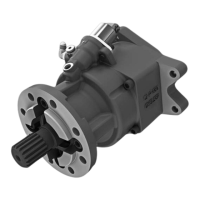6-40 Programming Your Application
590 Series DC Digital Converter
Functional Description
The following block diagram shows the internal structure of the PID block.
PID is used to control the response of any closed loop system. It is used specifically in system
applications involving the control of drives to allow zero steady state error between Reference
and Feedback, together with good transient performance.
Proportional Gain (PROP. GAIN)
This is used to adjust the basic response of the closed loop control system. It is defined
as the portion of the loop gain fed back to make the complete control loop stable. The
PID error is multiplied by the Proportional Gain to produce an output.
DIVIDER 1
Range: -3.0000 to 3.0000
This divides Input 1 by a factor (Divider 1).
DIVIDER 2
Range: -3.0000 to 3.0000
This divides Input 2 by a factor (Divider 2).
ENABLE
Range: ENABLED/DISABLED
A digital input which resets the (total) PID Output as well as the integral term when FALSE.
INT. DEFEAT
Range: ON/OFF
A digital input which resets the integral term when TRUE. The block transfer function then
becomes P+D only.
FILTER T.C.
Range: 0.000s to 10.000s
In order to attenuate high-frequency noise a first order filter is added in conjunction with the
differentiator. The ratio k of the Derivative Time Constant (Td) over the Filter Time Constant
(Tf) (typically 4 or 5) determines the high-frequency lift of the transfer function. For Tf = 0 this
filter is eliminated.
MODE
Range: 0 to 4
This determines the law which the profiler follows versus diameter.
For Mode = 0, Profiled Gain = constant = P.
For Mode = 1, Profiled Gain = A * (diameter - min diameter) + B.
For Mode = 2, Profiled Gain = A * (diameter - min diameter)^2 + B.
For Mode = 3, Profiled Gain = A * (diameter - min diameter)^3 + B.
For Mode = 4, Profiled Gain = A * (diameter - min diameter)^4 + B.
MIN PROFILE GAIN
Range: 0.00% to 100.00%
This expresses the minimum gain required at min diameter (core) as a percentage of the (max) P
gain at full diameter (100%).
PROFILED GAIN
Range: 0.0 to 100.0
The output of a profiler block which varies the gain versus diameter. This is primarily to be used
with Speed Profiled Winders for compensation against varying diameter and therefore inertia.
When MODE is not ZERO (see above) this overrides the P gain above.
PID OUTPUT
Refer to the DIAGNOSTICS function block description, page 6-
18.
PID CLAMPED
Refer to the DIAGNOSTICS function block description, page 6-
18.
PID ERROR
Refer to the DIAGNOSTICS function block description, page 6-
18.

